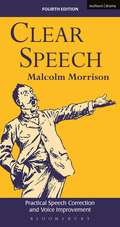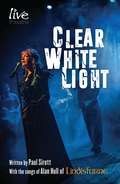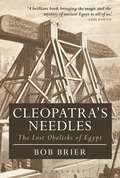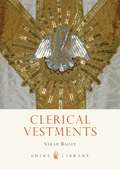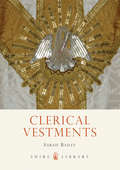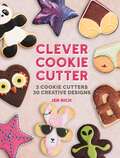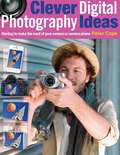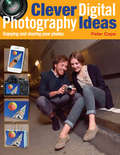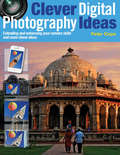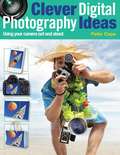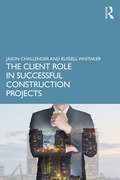- Table View
- List View
Clear Speech: Practical Speech Correction and Voice Improvement (Performance Books)
by Malcolm MorrisonThis book gives clear guidance to good pronunciation and is written in an easily-accessible form. Many people can identify and solve their speech problems and significantly improve their voice by using tried and tested exercises. The systematic arrangement of the material with clear illustrations makes it easy for the layman to understand and work from effectively. This new edition contains additional exercises as well as an expanded chapter on Indistinct Speech.
Clear Speech: Practical Speech Correction and Voice Improvement (Performance Books)
by Malcolm MorrisonThis book gives clear guidance to good pronunciation and is written in an easily-accessible form. Many people can identify and solve their speech problems and significantly improve their voice by using tried and tested exercises. The systematic arrangement of the material with clear illustrations makes it easy for the layman to understand and work from effectively. This new edition contains additional exercises as well as an expanded chapter on Indistinct Speech.
»Clear the Air«. Künstlermanifeste seit den 1960er Jahren: Interdisziplinäre Positionen (Edition Kulturwissenschaft #115)
by Burcu Dogramaci Katja Schneider1965 formulierte die Choreographin Yvonne Rainer ihr radikales No Manifesto. Es begann mit den Worten »NO to spectacle« und wurde zu einem der wirkmächtigsten Manifeste in der Kunst: Es sollte »die Luft klären«. Ob dies gelungen ist, welche Wirkungskraft künstlerische Manifeste seither entfalten, wie sie sich in unterschiedlichen medialen Kontexten und im digitalen Zeitalter niederschlagen und welche politischen Perspektiven ihnen inhärent sind, zeigen die Beiträger_innen des interdisziplinären Bandes u.a. an Beispielen der Gruppe SPUR, Georg Baselitz, Pina Bausch oder Kanak Attack.
Clear White Light (Oberon Modern Plays)
by Paul SirettA contemporary retelling of a classic gothic story, inspired by Edgar Allan Poe’s The Fall of the House of Usher, set against a background of cuts to our 70-year-old NHS.Alison is heading to her first shift at St Nicholas’s Hospital in Gosforth. She’s nervous. It’s a night shift on an all-male psychiatric unit and she hasn’t finished her training yet. But Rod, the senior Staff Nurse, seems to know what to do. Take a deep breath...Inspired by Alan Hull’s time working at St Nick’s the play features many of the hit songs he wrote at that time, including Winter Song, Lady Eleanor and Clear White Light played by a live band. Live Theatre wants to bring this incredible music to a new generation.Clear White Light is based on Edgar Allan Poe’s short story The Fall of the House of Usher and written by Olivier Award-nominated writer Paul Sirett.
Cleavage, Connection and Conflict in Rural, Urban and Contemporary Asia (ARI - Springer Asia Series #3)
by Tim Bunnell, D. Parthasarathy and Eric C. ThompsonAsia, the location of the world’s fastest-growing economies, is also home to some of the fastest rates of urbanization humanity has ever seen, a process whose speed renders long-term outcomes highly unpredictable. This volume contrasts with much published work on the rural/urban divide, which has tended to focus on single case studies. It provides empirical perspectives from four Asian countries: India, Indonesia, Malaysia, and Thailand, and includes a wealth of insights that both critique and expand popular notions of the rural-urban divide. The volume is relevant not just to Asian contexts but to social scientific research on population dynamics more generally. Rather than deploying a single study to chart national trends, three chapters on each country make possible much more complex perspectives. As a result, this volume does more than extend our understanding of the interplay between cities and hinterlands within Asia. It enhances our notions of rural/urban cleavages, connections and conflicts more generally, with data and analysis ready for application to other contexts. Of interest to diverse scholars across the social sciences and Asian studies, this work includes accounts ranging from rural youth real estate entrepreneurs in Hyderabad, India, to social development in Aceh province in Indonesia, devastated by the 2004 tsunami, to the relationship between urban space and commonly held notions of the supernatural in Thailand’s northern city of Chiang Mai.
Clement Greenberg Between the Lines: Including a Debate with Clement Greenberg
by Thierry de DuveClement Greenberg (1909–1994), champion of abstract expressionism and modernism—of Pollock, Miró, and Matisse—has been esteemed by many as the greatest art critic of the second half of the twentieth century, and possibly the greatest art critic of all time. This volume, a lively reassessment of Greenberg’s writings, features three approaches to the man and his work: Greenberg as critic, doctrinaire, and theorist. The book also features a transcription of a public debate with Greenberg that de Duve organized at the University of Ottawa in 1988. Clement Greenberg Between the Lines will be an indispensable resource for students, scholars, and enthusiasts of modern art. “In this compelling study, Thierry de Duve reads Greenberg against the grain of the famous critic’s critics—and sometimes against the grain of the critic himself. By reinterpreting Greenberg’s interpretations of Pollock, Duchamp, and other canonical figures, de Duve establishes new theoretical coordinates by which to understand the uneasy complexities and importance of Greenberg’s practice.” John O’Brian, editor of Clement Greenberg: The Collected Essays and Criticisms “De Duve is an expert on theoretical aesthetics and thus well suited to reassess the formalist tenets of the late American art critic's theory on art and culture. . . . De Duve's close readings of Greenberg . . . contain much of interest, and the author clearly enjoys matching wits with ‘the world's best known art critic.’” Library Journal
Clement Greenberg Between the Lines: Including a Debate with Clement Greenberg
by Thierry de DuveClement Greenberg (1909–1994), champion of abstract expressionism and modernism—of Pollock, Miró, and Matisse—has been esteemed by many as the greatest art critic of the second half of the twentieth century, and possibly the greatest art critic of all time. This volume, a lively reassessment of Greenberg’s writings, features three approaches to the man and his work: Greenberg as critic, doctrinaire, and theorist. The book also features a transcription of a public debate with Greenberg that de Duve organized at the University of Ottawa in 1988. Clement Greenberg Between the Lines will be an indispensable resource for students, scholars, and enthusiasts of modern art. “In this compelling study, Thierry de Duve reads Greenberg against the grain of the famous critic’s critics—and sometimes against the grain of the critic himself. By reinterpreting Greenberg’s interpretations of Pollock, Duchamp, and other canonical figures, de Duve establishes new theoretical coordinates by which to understand the uneasy complexities and importance of Greenberg’s practice.” John O’Brian, editor of Clement Greenberg: The Collected Essays and Criticisms “De Duve is an expert on theoretical aesthetics and thus well suited to reassess the formalist tenets of the late American art critic's theory on art and culture. . . . De Duve's close readings of Greenberg . . . contain much of interest, and the author clearly enjoys matching wits with ‘the world's best known art critic.’” Library Journal
Cléo de 5 a 7 (BFI Film Classics)
by Steven UngarCléo de 5 à 7 (Cléo from 5 to 7), Agnes Varda's classic 1962 work depicts, in near real-time, 90 minutes in the life of Cléo, a young woman in Paris awaiting the results of medical tests that she fears will confirm a fatal condition. The film, whose visual beauty matches its evocation of early-Fifth Republic Paris, was a major point of reference for the French New Wave despite the fact that Varda never considered herself a member of the core Cahiers du cinéma group of critics-turned- film-makers. Ungar provides a close reading of the film and situates it in its social, political and cinematic contexts, tracing Varda's early career as a student of art history and as a photographer, the history of post-war French film, and the lengthy Algerian war to which Cléo's health concerns and ambitions to become a pop singer make her more or less oblivious. His study is the first to set a reading of Cléo's formal and technical complexity alongside an analysis of its status as a visual document of its historical moment. Steven Ungar's foreword to this new edition looks back upon Varda's film-making career and considers her contributions as a female auteur and in the context of the French New Wave.
Cléo de 5 a 7 (BFI Film Classics)
by Steven UngarCléo de 5 à 7 (Cléo from 5 to 7), Agnes Varda's classic 1962 work depicts, in near real-time, 90 minutes in the life of Cléo, a young woman in Paris awaiting the results of medical tests that she fears will confirm a fatal condition. The film, whose visual beauty matches its evocation of early-Fifth Republic Paris, was a major point of reference for the French New Wave despite the fact that Varda never considered herself a member of the core Cahiers du cinéma group of critics-turned- film-makers. Ungar provides a close reading of the film and situates it in its social, political and cinematic contexts, tracing Varda's early career as a student of art history and as a photographer, the history of post-war French film, and the lengthy Algerian war to which Cléo's health concerns and ambitions to become a pop singer make her more or less oblivious. His study is the first to set a reading of Cléo's formal and technical complexity alongside an analysis of its status as a visual document of its historical moment. Steven Ungar's foreword to this new edition looks back upon Varda's film-making career and considers her contributions as a female auteur and in the context of the French New Wave.
Cleopatra and Rome
by Diana E. KleinerWith the full panorama of her life forever lost, Cleopatra touches us in a series of sensational images: floating through a perfumed mist down the Nile; dressed as Venus for a tryst at Tarsus; unfurled from a roll of linens before Caesar; couchant, the deadly asp clasped to her breast. Through such images, each immortalizing the Egyptian queen's encounters with legendary Romans--Julius Caesar, Mark Antony, and Octavian Augustus--we might also chart her rendezvous with the destiny of Rome. So Diana Kleiner shows us in this provocative book, which opens an entirely new perspective on one of the most intriguing women who ever lived. Cleopatra and Rome reveals how these iconic episodes, absorbed into a larger historical and political narrative, document a momentous cultural shift from the Hellenistic world to the Roman Empire. In this story, Cleopatra's death was not an end but a beginning--a starting point for a wide variety of appropriations by Augustus and his contemporaries that established a paradigm for cultural conversion. In this beautifully illustrated book, we experience the synthesis of Cleopatra's and Rome's defining moments through surviving works of art and other remnants of what was once an opulent material culture: religious and official architecture, cult statuary, honorary portraiture, villa paintings, tombstones, and coinage, but also the theatrical display of clothing, perfume, and hair styled to perfection for such ephemeral occasions as triumphal processions or barge cruises. It is this visual culture that best chronicles Cleopatra's legend and suggests her subtle but indelible mark on the art of imperial Rome at the critical moment of its inception.
Cleopatra and the Undoing of Hollywood: How One Film Almost Sunk the Studios
by Patrick HumphriesCleopatra has its place as one of the most fabled films of all time. While others have won more Oscars, attracted better reviews and taken more money at the box office, the 1963 film starring Elizabeth Taylor and Richard Burton stands alone in cinema legend. What began in 1958 as a $2 million vehicle for Joan Collins eventually opened five years later, having cost more than twenty times that amount. The making of the film soon became a cautionary tale, for the lavish extravagance of Cleopatra all but bankrupted 20th Century Fox and almost singlehandedly set in motion the decline of the major studios. Actors and filmmakers were hired and fired at a breathtaking rate, and by the time the film was finally released, Hollywood could only watch in horror as it died at the box office. This is an epic tale of love and lust; of gossip, money, sex, movie-star madness, studio politics and the birth of paparazzi journalism. Within the saga of Cleopatra lies the end of the era of Hollywood’s studio system, the seeds of the Swinging Sixties, and the stuff of timeless movie legend.
Cleopatra's Needles: The Lost Obelisks of Egypt (Bloomsbury Egyptology)
by Bob BrierIn the half-century between 1831 and 1881 three massive obelisks left Egypt for new lands. Prior to these journeys, the last large obelisk moved was the Vatican obelisk in 1586 – one of the great engineering achievements of the Renaissance. Roman emperors moved more than a dozen, but left no records of how they did it. The nineteenth-century engineers entrusted with transporting the obelisks across oceans had to invent new methods, and they were far from certain that they would work. As the three obelisks, bound for Paris, London and New York, sailed towards their new homes, the world held its breath. Newspapers reported the obelisks' daily progress, complete with dramatic illustrations of the heroic deeds of the engineers and crews struggling under nearly impossible conditions. When the obelisks finally arrived safely in their new homes, bands played Cleopatra's Needle Waltz and silver obelisk pencils dangled from fashionable ladies' necks. This turbulent era, caught up in obelisk mania, is recreated by Bob Brier in all its glory. Amid astounding tales of engineering dexterity and naval endurance, the individuals involved in transporting the obelisks and receiving them in their future homes are brought to life through their letters and diaries, newspaper articles and illustrations. Written by a renowned Egyptologist and author, this compelling book will fascinate all those interested in Egypt, its iconic monuments and the history of great endeavour.
Cleopatra's Needles: The Lost Obelisks of Egypt (Bloomsbury Egyptology)
by Bob BrierIn the half-century between 1831 and 1881 three massive obelisks left Egypt for new lands. Prior to these journeys, the last large obelisk moved was the Vatican obelisk in 1586 – one of the great engineering achievements of the Renaissance. Roman emperors moved more than a dozen, but left no records of how they did it. The nineteenth-century engineers entrusted with transporting the obelisks across oceans had to invent new methods, and they were far from certain that they would work. As the three obelisks, bound for Paris, London and New York, sailed towards their new homes, the world held its breath. Newspapers reported the obelisks' daily progress, complete with dramatic illustrations of the heroic deeds of the engineers and crews struggling under nearly impossible conditions. When the obelisks finally arrived safely in their new homes, bands played Cleopatra's Needle Waltz and silver obelisk pencils dangled from fashionable ladies' necks. This turbulent era, caught up in obelisk mania, is recreated by Bob Brier in all its glory. Amid astounding tales of engineering dexterity and naval endurance, the individuals involved in transporting the obelisks and receiving them in their future homes are brought to life through their letters and diaries, newspaper articles and illustrations. Written by a renowned Egyptologist and author, this compelling book will fascinate all those interested in Egypt, its iconic monuments and the history of great endeavour.
Clerical Vestments: Ceremonial Dress of the Church (Shire Library)
by Sarah BaileyThe churches of Britain contain a remarkable heritage of exquisitely embroidered vestments, and cathedrals in particular hold some of the most beautiful textiles ever produced in Europe. The history of these priestly garments and how their use developed in Britain and Europe is fascinating. This book outlines the tradition and mysticism associated with them and the role they still play in the 'theatre' of church, and shows how colour and ornament are used in the symbolism of the Christian faith. It explores the history of vestment production up to the present day, covering the practicalities of design, the sourcing of fabrics and the embroiderers themselves.
Clerical Vestments: Ceremonial Dress of the Church (Shire Library #727)
by Sarah BaileyThe churches of Britain contain a remarkable heritage of exquisitely embroidered vestments, and cathedrals in particular hold some of the most beautiful textiles ever produced in Europe. The history of these priestly garments and how their use developed in Britain and Europe is fascinating. This book outlines the tradition and mysticism associated with them and the role they still play in the 'theatre' of church, and shows how colour and ornament are used in the symbolism of the Christian faith. It explores the history of vestment production up to the present day, covering the practicalities of design, the sourcing of fabrics and the embroiderers themselves.
Clerk of Works and Site Inspector Handbook: 2018 Edition
by The Institute of Clerks of Works and Construction InspectorateThis new edition of the popular handbook is a practical companion for Clerks of Works, Site Inspectors and anyone with the responsibility of managing construction works on site. Clerk of Works and Site Inspector Handbook, 2018 edition the book explains the traditional site inspector/clerk of works role and their liabilities, as well as duties and responsibilities linked to a more contemporary construction setting. It explores the relationship between inspectors, architects and other construction professionals, whilst providing valuable insight into reporting and what to look for, check and test every step of the way. It's an essential reference book for Clerks of Works and Site Inspectors, containing important lessons for newly qualified architects, those who carry out site inspections or act as resident site architects and Part 3 students.
Clerk of Works and Site Inspector Handbook: 2018 Edition
by The Institute of Clerks of Works and Construction InspectorateThis new edition of the popular handbook is a practical companion for Clerks of Works, Site Inspectors and anyone with the responsibility of managing construction works on site. Clerk of Works and Site Inspector Handbook, 2018 edition the book explains the traditional site inspector/clerk of works role and their liabilities, as well as duties and responsibilities linked to a more contemporary construction setting. It explores the relationship between inspectors, architects and other construction professionals, whilst providing valuable insight into reporting and what to look for, check and test every step of the way. It's an essential reference book for Clerks of Works and Site Inspectors, containing important lessons for newly qualified architects, those who carry out site inspections or act as resident site architects and Part 3 students.
Clever Cookie Cutter: How to Make Creative Cookies with Simple Shapes
by Jen RichEverybody loves delicious, perfectly decorated cookies - the kind that look almost too good to eat (not that that ever stopped us). But who needs a whole drawerful of cookie cutters in every shape and size that gets left to collect dust in the dark corners of your kitchen, never to be used again?Clever Cookie Cutter will show you how to create 30 incredible cookie designs using just 3 simple cookie cutters - a heart, a gingerbread man and a star. From fabulous flamingos to bootylicious bums and boobs or out-of-this-world aliens to magical unicorns, this little book will have you covered no matter the occasion or your mood. And handy tips and techniques, plus basic dough and icing recipes, make cookie decorating a breeze, no matter your level of skill (or patience). So you'll be able to impress your friends, delight your family and maybe even surprise yourself along the way.- Transform heart-shaped cookies into fabulous flamingos, sumptuous strawberries and beautiful butterflies.- Turn gingerbread men into luscious monstera, fearsome sharks or spooky zombies.- Take star-shaped cookies and turn them into purr-fect cats, magical unicorns and spring-time daffodils.- Plus, pick up handy tips and techniques for the best cookies you've ever made.
Clever Digital Photography Ideas: Starting to make the most of your camera or camera phone
by Peter CopeA practical, accessible guide to the ingenious and creative things that can be done with a digital compact or camera phone. Clever Digital Photography Ideas: Starting to make the most of your camera or camera phone is a chapter from the book 100 Clever Digital Photography Ideas and provides a variety of simples ideas for getting even more from your camera or camera phone than just a record of those memorable moments. This includes exploring the camera's functions, ingenious ways to record information and photography your hobbies and interests.All ideas and projects are presented with easy to follow instructions and striking photographs across colourful pages. Open your eyes to the creative possibilities with your digital photo technology, from using a basic compact camera to the latest smart phone. Whether a novice or a pro, Clever Digital Photography Ideas: Starting to make the most of your camera or camera phone will show you how to break out of your comfort zone and try something exciting and new.
Clever Digital Photography Ideas: Starting to make the most of your camera or camera phone
by Peter CopeA practical, accessible guide to the ingenious and creative things that can be done with a digital compact or camera phone. Clever Digital Photography Ideas: Starting to make the most of your camera or camera phone is a chapter from the book 100 Clever Digital Photography Ideas and provides a variety of simples ideas for getting even more from your camera or camera phone than just a record of those memorable moments. This includes exploring the camera's functions, ingenious ways to record information and photography your hobbies and interests.All ideas and projects are presented with easy to follow instructions and striking photographs across colourful pages. Open your eyes to the creative possibilities with your digital photo technology, from using a basic compact camera to the latest smart phone. Whether a novice or a pro, Clever Digital Photography Ideas: Starting to make the most of your camera or camera phone will show you how to break out of your comfort zone and try something exciting and new.
Clever Digital Photography Ideas - Enjoying and sharing your photos
by Peter CopeA practical, accessible guide to the ingenious and creative things that can be done with a digital compact or camera phone. Clever Digital Photography Ideas: Enjoying and sharing your photos is an extract from the book 100 Clever Digital Photography Ideas and provides a variety of simples ideas to take your photographs beyond the photo frame or photo album. Digital technology has meant that you can print on almost anything in virtually any size, from everyday canvases to the more creative mobile phone cases, and wallpaper! You can create your own Hockney joiner or Banksy style artwork, and you can share your photos online through websites and blogs. There are even clever ideas for selling your photographs.All ideas and projects are presented with easy to follow instructions and striking photographs across colourful pages. Open your eyes to the creative possibilities with your digital photo technology, from using a basic compact camera to the latest smart phone. Whether a novice or a pro, Clever Digital Photography Ideas: Enjoying and sharing your photos will show you how to break out of your comfort zone and try something exciting and new.
Clever Digital Photography Ideas - Extending and enhancing your camera skills and more clever ideas
by Peter CopeA practical, accessible guide to the ingenious and creative things that can be done with a digital compact or camera phone. Clever Digital Photography Ideas: Extending and enhancing your camera skills and more clever ideas is an extract from the book 100 Clever Digital Photography Ideas and provides a variety of simples ideas for pushing your camera skills that little but further. From how you can shoot when conditions get a bit extreme, to creating breath-taking panoramas, and even three-dimensional photos. Shooting movies is also covered, with some ingenious ideas to become more creative in the movie-making arena. There are also clever ideas for protecting your photos for the future, including shooting in RAW. The second part of the eBook covers getting more from your camera and camera phone, guiding you through what all the buttons and jargon mean, as well as clever ideas for extending your battery life and fun ways to use your old camera.All ideas and projects are presented with easy to follow instructions and striking photographs across colourful pages. Open your eyes to the creative possibilities with your digital photo technology, from using a basic compact camera to the latest smart phone. Whether a novice or a pro, Clever Digital Photography Ideas: Extending and enhancing your camera skills and more clever ideast will show you how to break out of your comfort zone and try something exciting and new.
Clever Digital Photography Ideas: Using Your Camera Out and About
by Peter CopeA practical, accessible guide to the ingenious and creative things that can be done with a digital compact or camera phone. Clever Digital Photography Ideas: Using Your Camera Out and About is a chapter from the book 100 Clever Digital Photography Ideas and provides a variety of simples ideas for getting more from your camera or camera phone when you are out and about, beyond your travels and holidays. Some ideas might be obvious, like tips for shooting landscapes, but many are more obscure and fun, like creating a visual gift list and using your camera as binoculars. With so many people owning camera phones these days, there's no excuse not to be taking photographs whilst you are out and about.All ideas and projects are presented with easy to follow instructions and striking photographs across colourful pages. Open your eyes to the creative possibilities with your digital photo technology, from using a basic compact camera to the latest smart phone. Whether a novice or a pro, Clever Digital Photography Ideas: Using Your Camera Out and About will show you how to break out of your comfort zone and try something exciting and new.
The Client Role in Successful Construction Projects
by Jason Challender Russell WhitakerThe Client Role in Successful Construction Projects is a practical guide for clients on how to initiate, procure and manage construction projects and developments. This book is written from the perspective of the client initiating a construction project as part of a business venture and differs from most available construction literature which can externalise the client as a risk to be managed by the design team. The book provides a practical framework for new and novice clients undertaking construction, giving them a voice and enabling them to: Understand the challenges that they and the project are likely to face. Communicate and interact effectively with key stakeholders and professionals within the industry. Understand in straightforward terms where they can have a positive impact on the project. Put in place a client-side due diligence process. Reduce their institutional risk and the risk of project failure. Discover how their standard models are able to co-exist and even transfer to a common client-side procedure for managing a construction project. Written by clients, for clients, this book is highly recommended not only for clients, but for construction industry professionals who want to develop their own skills and enhance their working relationship with their clients. A supporting website for the book will be available, which will give practical examples of the points illustrated in the book and practical advice from specialists in the field.
The Client Role in Successful Construction Projects
by Jason Challender Russell WhitakerThe Client Role in Successful Construction Projects is a practical guide for clients on how to initiate, procure and manage construction projects and developments. This book is written from the perspective of the client initiating a construction project as part of a business venture and differs from most available construction literature which can externalise the client as a risk to be managed by the design team. The book provides a practical framework for new and novice clients undertaking construction, giving them a voice and enabling them to: Understand the challenges that they and the project are likely to face. Communicate and interact effectively with key stakeholders and professionals within the industry. Understand in straightforward terms where they can have a positive impact on the project. Put in place a client-side due diligence process. Reduce their institutional risk and the risk of project failure. Discover how their standard models are able to co-exist and even transfer to a common client-side procedure for managing a construction project. Written by clients, for clients, this book is highly recommended not only for clients, but for construction industry professionals who want to develop their own skills and enhance their working relationship with their clients. A supporting website for the book will be available, which will give practical examples of the points illustrated in the book and practical advice from specialists in the field.
